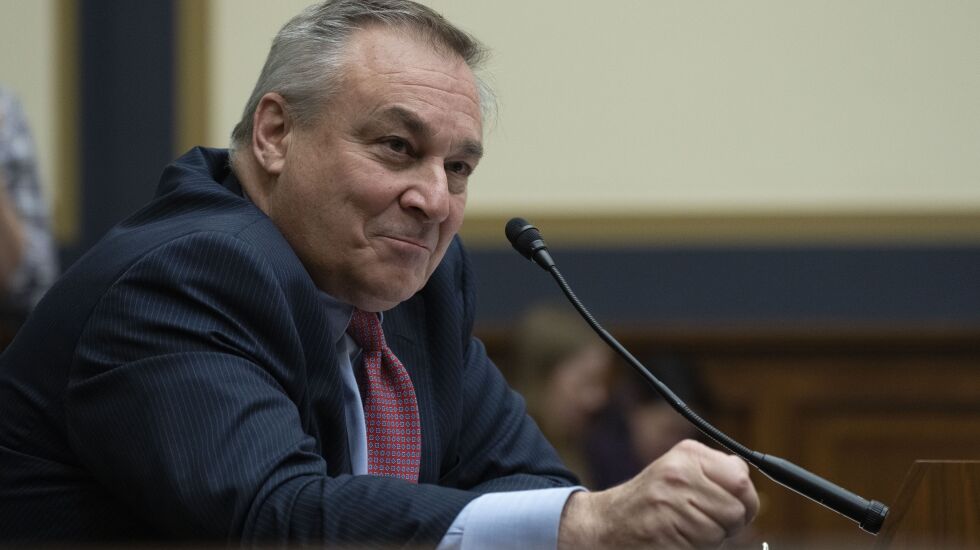
Sam Bankman-Fried, who sold himself as a T-shirt-wearing, video-gaming whiz kid disrupting all things financial, has been arrested in the collapse of his FTX cryptocurrency exchange.
It’s shaping up as the biggest scandal roaring through the markets since Bernie Madoff’s Ponzi scheme and, irrespective of Bankman-Fried’s guilt or innocence, it’s making a lot of supposed sharpies look very bad.
They include funders such as Chicago-based private equity firm Thoma Bravo, the Ontario Teachers Pension Fund and Sequoia Capital. Sequoia published a glowing profile of Bankman-Fried weeks before it wrote off the value of its investment with him. It described how he played League of Legends while on a call with the firm, taking that as a good thing. By some accounts, federal regulators were quite late on the case.
Many FTX backers issued statements after its Nov. 11 bankruptcy about the rigor of their vetting processes. It’s puzzling how so many people with advanced degrees and powerful computer programs missed what John Ray III, the executive brought in to clean up the mess, called “just old-fashioned embezzlement. This is just taking money from customers and using it for your own purpose.” Ray told Congress customers may have lost $8 billion.

Clearly, none of the backers listened to early warnings from a Chicago business executive who knows something about risk management.
Terrence Duffy is the chairman of CME Group, the largest futures exchange in the U.S. It’s the amalgam of the Chicago Mercantile Exchange, the Chicago Board of Trade, the New York Mercantile Exchange and other assets. He sounded alarms about possible problems with FTX early on and said in March he called Bankman-Fried a fraud to his face.
A week after the FTX implosion, Duffy went on the On the Tape podcast to elaborate on the conversation. It started with talk of a business deal but quickly turned sour when Duffy said it was clear FTX had no plan to isolate risk in crypto trading. “I said, ‘Your model is crap. Why would I deploy a model that’s going to introduce risk to the system?’” Duffy said on the podcast.
At the time, Bankman-Fried was said to be worth $26 billion. As Duffy recounted it, “I said, ‘My net worth doesn’t start with any b’s. I’ll give you a 3 to 1 that I have more money than you.’ I said, ‘I’ll tell you what, I’ll give you a 4 to 1 I got more money in my right pocket than your net worth.’ I said, ‘You’re a fraud, and I’m going to make sure that we get this out there.’ And that was it. So we went to Congress.”
It sounds like a South Side guy talking. Duffy is among the longest-serving chairmen in Chicago business, having gotten there without a wealthy background or an MBA. He grew up in Mount Greenwood, where his parents had a floral shop. He tended bar, including at She-nannigan’s on Division Street, thinking of becoming a cop or firefighter.
His parents mortgaged their house so he could lease his first membership at the old Merc in 1981. He once said he paid them back in two years. On the trading floor, he made connections and earned people’s trust. After serving on the exchange’s board, he was named Merc chairman in 2002 and has led it through its absorption of the Board of Trade and transformative growth.
He testified before the U.S. House Agriculture Committee in May about FTX’s dangers with Bankman-Fried sitting next to him. Both were clearly uncomfortable.
Duffy’s written testimony was jargony but carefully laid out what he saw as deficiencies in FTX’s operation compared with futures markets, which has several levels of protections against trading defaults. CME Group calls the protections its “default waterfall” on its website.
Duffy said futures trading firms hold $173 billion to cover trading risks. FTX was proposing an algorithm that would in stages liquidate accounts depending on how prices fluctuated. “The proposal as put forth is fraught with dangers,” Duffy said. He called it “risk management light” that would destabilize financial markets beyond crypto.
Since that hearing, the FTX story has gotten worse. Federal prosecutors have charged Bankman-Fried with running a brazen scheme to apply customer funds toward real estate purchases and political contributions and to cover losses at Alameda Research, a crypto hedge fund he founded. Bankman-Fried has admitted his operations lacked basic financial controls but denied an intent to defraud.
Ray, who worked on the Enron case, described the alleged fraud as years in the making.
Why do people fall for this stuff? Chalk it up to ego, lazy due diligence and that bane of money managers, the fear of missing out.
Investors and regulators should have taken to heart Duffy’s clear-eyed Chicago view. Tending bar and making your mark on the old trading floors can qualify you to spot trouble ahead.







